Select Hazmat > Add Hazmat Code. The Add New Hazmat Code page is displayed (see Exhibit 40) showing the Hazmat section with initial hazmat code input fields. Additional sections follow for the Regulatory Agency and Emergency Response fields.
Exhibit 40. Add New Hazmat Code – Hazmat Section
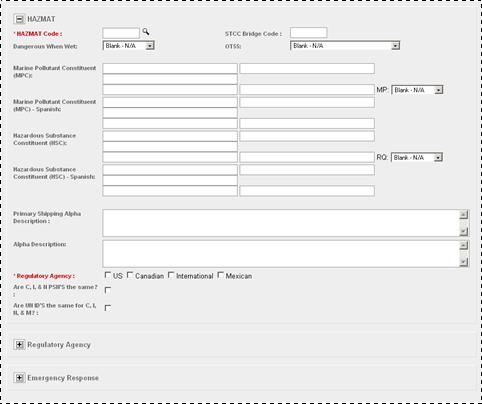
Complete the available input fields for the Hazmat section.
|
Field |
Description |
|
* Hazmat Code |
The Hazardous Material Response Code is a unique seven (7) digit code used to classify a commodity or group of commodities. The first two digits of the HMRC are either 48 or 49. 48 – Hazardous Waste (these codes will never have a STCC number associated) 49 – Hazardous Material Response Code (these codes will always have an associated STCC number)
Duplicate codes not allowed. Cannot use a code which has been expired in last 5 years. |
|
STCC Bridge Code |
7 character numeric. Must be a valid STCC Code. Mandatory if Hazmat Code begins with 49.
The Standard Transportation Commodity Code (STCC) Number contains a product class STCC code that corresponds to the Hazardous Material Response Code (HMRC). The field is required for HMRCs starting with 49, and must not be coded for HMRCs starting with 48. When coded it must be all numeric and in the STCC Master File. |
|
Dangerous When Wet |
Indicate that the commodity requires the statement “Dangerous When Wet” on shipping papers.
D – Commodity description may require the phrase “Dangerous When Wet” Blank – Not Applicable |
|
OT55 |
The Operations/Transportation-55 (OT-55) field is a flag used to identify those commodities for which Circular OT 55 "KEY TRAIN" AND "KEY ROUTES" apply. One of the following codes must be entered:
E – Environmentally sensitive chemical F – Flammable gas P – Poison inhalation R – Radioactive X – Class A Explosives or Class 1.1 and 1.2 Blank – OT-55 restrictions do not apply
|
|
Marine Pollutant Constituent (MPC) |
Name of the appropriate chemical component(s) when the Marine Pollutant Indicator Code equals M.
1-5 fields of 25 characters alphanumeric each in English. Mandatory free-form if Hazmat code is a marine pollutant (determined by selecting ‘M’ in the MP dropdown field). |
|
MP |
Used to identify Hazmat code as a marine pollutant (‘M’) by the US DOT. |
|
Marine Pollutant Constituent (MPC) Spanish |
Spanish Name of the appropriate chemical component(s) when the Marine Pollutant Indicator Code equals M.
1-5 fields of 25 characters alphanumeric each in Spanish. Mandatory free-form if Hazmat code is a marine pollutant (determined by selecting ‘M’ in the MP dropdown field). |
|
Hazardous Substance Constituent (HSC) |
HSC field contains the name of the appropriate chemical component(s) when the Reportable Quantity Code equals R.
5 fields of 25 characters alphanumeric each in English. Mandatory free-form if Hazmat code is a reportable quantity (determined by selecting ‘R’ in the RQ dropdown field). |
|
RQ |
RQ field is a flag to indicate that the US EPA has assigned a reportable quantity to a chemical component of the commodity.
R – Material has a reportable quantity (The RQ notation is not required if the amount in each container is less than the RQ for the material.) Blank – Not Applicable |
|
Hazardous Substance Constituent (HSC) Spanish |
HSC field contains the Spanish name of the appropriate chemical component(s) when the Reportable Quantity Code equals R.
5 fields of 25 characters alphanumeric each in Spanish. Mandatory free-form if Hazmat code is a reportable quantity (determined by selecting ‘R’ in the RQ dropdown field). |
|
Primary Shipping Alpha Description |
250 characters max alphanumeric; copied as default value for Proper Shipping Name for all regulatory agencies selected. |
|
Alpha Description |
An alternate alpha description provided when the Proper Shipping Name and the Technical Name provide inadequate description for the material. This field is provided for publication of the Alpha index to the Hazardous Materials Directory and for file look-ups. |
|
* Regulatory Agency |
Select Regulatory Agency (US, Canadian, Mexican, International). |
|
Are C, I, & N PSN'S the same? |
Select if the Proper Shipping Name (PSN) is the same for multiple regulatory agencies. |
|
Are UN/NA ID's the same for C, I, N, & M? |
Select if UN/NA ID’s are the same for multiple regulatory agencies. |
Select the plus sign (+) next to the Regulatory Agency label to view Regulatory Agency input fields.
Exhibit 41. Hazmat Regulatory Agency Information (US)
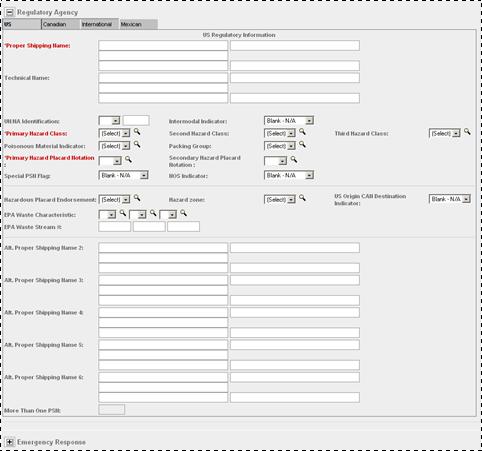
Complete the available input fields for Regulatory Agency Information (US).
Exhibit 42. Hazmat Regulatory Agency Information (US) Input Fields
|
Field |
Description |
|
* Proper Shipping Name |
The Proper Shipping Name contains the hazardous materials shipping name(s) required by international regulations. |
|
Technical Name |
Required to augment the NOS (not otherwise specified) flagged Proper Shipping Names. |
|
UN/NA Identification |
6 character; The United Nations/North America (UN/NA) number is the UN/NA identification number required by Canada. |
|
Intermodal Indicator |
Indicates that the hazardous material description is the appropriate one to use for intermodal shipments. |
|
* Primary Hazard Class |
This field contains the Hazard Class required by U.S. DOT (49 Code of Federal Regulations). It must be a 1 to 4 alphanumeric character. |
|
Second/Third Hazmat Class |
These fields contain the subsidiary hazard classes required by U.S. DOT (49 Code of Federal Regulations). There are two additional fields for hazard Class for Canada. If blanks none apply. It must be a 1 to 4 alphanumeric character.
|
|
Poisonous Material Indicator |
Indicates specific statements required for poisonous substances.
P – Poison I – Inhalation Hazard B – Poison Inhalation Hazard Blank – Not Applicable |
|
Packaging Group |
This field contains one of the following codes corresponding to Canadian, packing group designations:
1 – Packing Group I 2 – Packing Group II 3 – Packing Group III A – Packing Groups I, II or III B – Packing Groups I or II C – Packing Groups II or III D – Packing Groups I or III Blank – No Packing Group |
|
* Primary Hazard Placard Notation |
Code corresponding to the primary placard notation for the commodity |
|
Secondary Hazard Placard Notation |
Code that corresponds to the secondary hazard placard notation for the commodity |
|
Special PSN Flag |
Special PSN Flag indicates that the sequence of the U.S. DOT Proper Shipping Names words may vary, or that one of the modifying terms on the record should appear as part of the Proper Shipping Name
S – Regulatory Authority allows the Proper Shipping Name words to appear in any sequence M – One of the words on the record should be used with Proper Shipping Name Blank – not applicable |
|
NOS Indicator |
The Not Otherwise Specified (N.O.S.) Indicator is a flag to indicate that the U.S. DOT Proper Shipping Name must be augmented with a Technical Name.
N = The Proper Shipping Name must be augmented Blank - Not applicable |
|
Hazardous Placard Endorsement |
Code that identifies required placard endorsement statements |
|
Hazard Zone |
The DOT assigned Inhalation Toxicity Hazard Zone designation |
|
US Origin CAN Destination Indicator |
Code indicating those commodities that require special shipping descriptions when they are shipped from the US to Canada. A value of "U" indicates the commodity description must include special information when it is shipped across the US-Canadian border. |
|
EPA Waste Characteristic |
Code corresponding to EPA's waste characteristic. The EC must appear, in association with the Proper Shipping Name, on some manifested hazardous wastes. |
|
EPA Waste Stream # |
Required with the Proper Shipping Name for certain manifested hazardous wastes. |
|
Alternative Proper Shipping Name 2-6 |
Additional Proper Shipping Names (PSNs). |
|
More Than One PSN |
This field contains a flag to indicate that the pertinent Regulatory Authority permits more than one Proper Shipping Name for the commodity.
0 – Only one PSN will be allowed. 1 – Two PSN's will be allowed. 2 – Three PSN's will be allowed. 3 – Four PSN's will be allowed. 4 – Five PSN's will be allowed. 5 – Six PSN's will be allowed.
|
If necessary, select the Regulatory Agency – Canadian tab. The Regulatory Agency Information (CAN) is displayed.
Exhibit 43. Hazmat Regulatory Agency Information (Canadian)
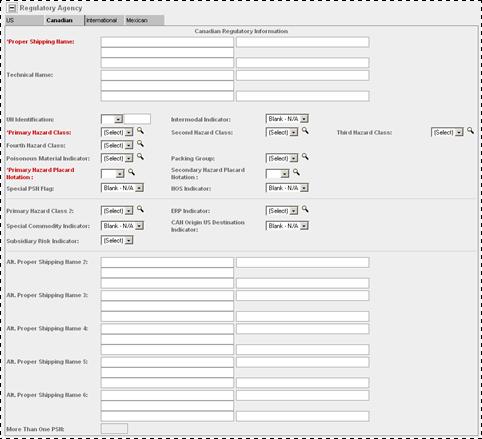
Complete the available input fields for Regulatory Agency Information (Canadian). See Exhibit 42. Hazmat Regulatory Agency Information (US) Input Fields for definitions of the majority of the screen fields. The following are input fields unique to Regulatory Agency Information (Canadian).
Exhibit 44. Hazmat Regulatory Agency Information (Canadian) Unique Input Fields
|
Field |
Description |
|
UN Identification |
This field contains the United Nations (UN) identification number (ID) required by Canadian (Transport Dangerous Goods regulations). |
|
ERP Indicator |
This field contains a flag to indicate that Canadian regulations may require that an Emergency Response Plan number and telephone number appear on the shipping paper. Choose one of the following;
E – ERP requirements may apply P – ERP requirements may apply to Packing Group I commodities only. Blank = not applicable |
|
Special Commodity Indicator |
This field contains a flag to indicate that Canadian regulations designate “SPECIAL COMMODITY” on the shipping papers, choose one of the following;
S – The statement “SPECIAL COMMODITY” must appear on the shipping papers. P – The statement “SPECIAL COMMODITY” must appear on the shipping papers for packing group I commodities. Blank – not applicable
|
|
CAN Origin US Destination Indicator |
This field contains a flag to indicate those dangerous goods that require special shipping descriptions when being shipped from Canada to the United States, choose the following;
C – The commodity description must include special information Blank – not applicable. |
|
Subsidiary Risk Indicator |
This field contains a codes corresponding to Canadian required information regarding Subsidiary Risks associated with the commodity, choose one of the following:
E – Potentially explosive I – Potentially very damaging to eyes X – Potentially explosive applies to Packing Group I only B – Potentially explosive and potentially very damaging to eyes Y – Potentially very damaging to eyes applies to Packing Group I only Z – Potentially explosive and potentially very damaging to eyes, this applies to Packing Group I only Blank – not applicable
|
If necessary, select the Regulatory Agency – Mexican tab. The Regulatory Agency Information (Mexican) is displayed.
Exhibit 45. Hazmat Regulatory Agency Information (Mexican)
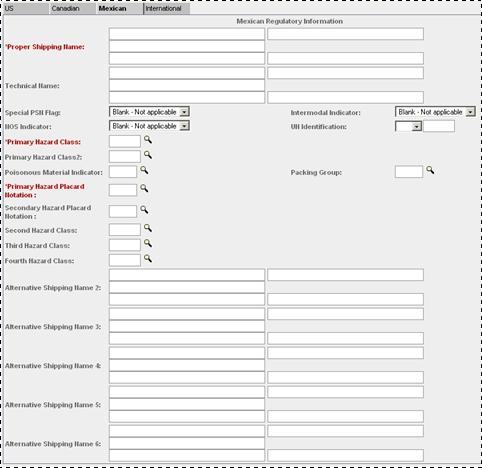
Complete the available input fields for Regulatory Agency Information (Mexican). See Exhibit 42. Hazmat Regulatory Agency Information (US) Input Fields and Exhibit 44. Hazmat Regulatory Agency Information (Canadian) Unique Input Fields for definitions of the screen fields.
If necessary, select the Regulatory Agency – International tab. The Regulatory Agency Information (International) is displayed.
Exhibit 46. Hazmat Regulatory Agency Information (International)
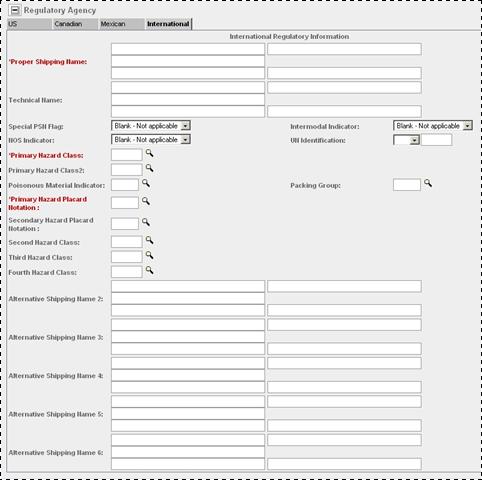
Complete the available input fields for Regulatory Agency Information (International). See Exhibit 42. Hazmat Regulatory Agency Information (US) Input Fields and Exhibit 44. Hazmat Regulatory Agency Information (Canadian) Unique Input Fields for definitions of the screen fields.
Select the plus sign (+) next to the Emergency Response label to view Emergency Response input fields.
Exhibit 47. Hazmat Emergency Response Information (English)
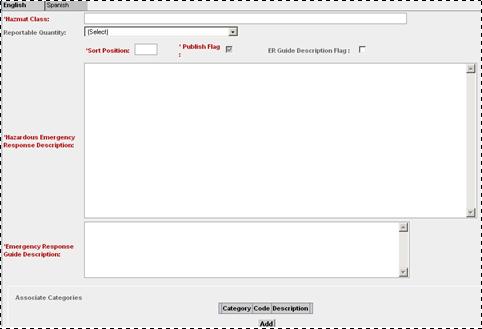
Complete the available input fields for Hazmat Emergency Response Information (English).
|
Field |
Description |
|
* Hazmat Class |
This field contains the Hazard Class required by regulation. The hazard class which may include the division along with the commodity class in parenthesis. Example: DIVISION 2.3 (NONFLAMMABLE GAS)
|
|
Reportable Quantity |
The Reportable Quantity indicates that the US EPA has assigned a Reportable Quantity to a chemical component of the commodity. The following are valid values:
Environmentally hazardous substance (rq-1 pound (0.454 kilograms)) Environmentally hazardous substance (rq-10 pounds (4.54 kilograms)) Environmentally hazardous substance (rq-100 pounds (45.4 kilograms)) Environmentally hazardous substance (rq-1000 pounds (454 kilograms)) Environmentally hazardous substance (rq-5000 pounds (2270 kilograms))
|
|
* Sort Position |
Specifies what position to begin sorting the Proper Shipping Name for hardcopy publication. |
|
* Publish Flag |
Y – Print in the publication (default) N – Do not print in publication
Note the following on its intended use: When adding a new HazMat code, retrieve a code to use as a model. When changing only the STCC bridge code, extract the original HazMat code from the Emergency Response Data Base as a model and change only the HazMat code. In this instance there should not be a Publish Flag indicator. This assumes that there is already a publish flag for one of the HazMat Codes that are identical in all respects except for the STCC bridge code. If there is a request for a new HazMat Code for a non N.O.S. description (e.g. Ammonia Solution which has several entries), do the same. One of the HazMat Codes for this case will have the Intermodal Indicator flag, which should be the one used as the model, and which should be the one with the Publish Flag. Any code with the Intermodal Indicator flag set should have the Publish Flag. Otherwise, an N.O.S. proper shipping name from 172.101 table without a technical name will not get printed in Emergency Handling. |
|
ER Guide Description Flag |
Flags if the PSN is different from the entry in the ER file |
|
* Hazardous Emergency Response Description |
This field is used to describe the Hazardous Material Emergency Response.
|
|
* Emergency Response Description |
This field is used to describe the Emergency Response.
|
Optionally, add an associate category by selecting Add. Input fields are provided to add this information. The Emergency Response is divided into 9 Header ER Categories. Under each header there has associated categories. Each associated category has a code applied
Exhibit 48. Add Associate Catagory

If necessary, select the Spanish tab. The input fields are identical to those on the English tab. Complete the input fields in Spanish.
Perform one of the processing options shown in Exhibit 49.